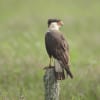 By Jim Stevenson
By Jim Stevenson
We have a scheduled field trip for a half day Wednesday but with the passing of this front Tuesday, it might be a great day. Therefore, if you wanna attend the regularly-scheduled 8-noon, it’s $25, as usual. However, some of you might wanna stay the whole day, given the possibility of a major event, so a full day will be $40. You don’t even need to make a commitment on which now. Just tell me you’re coming at 8 am and we’ll take it from there. K?
I got a huge response from the “teaching” gallery last week so I’ve prepared another one (in all my spare time!). It deals with pairs of similar species shot recently, and how to tell them apart. Many of you beginners are graduating from milk and honey to meat, so this will guide you along. We had a wonderful trip to Grand Isle, Louisiana, with hordes of tanagers, grosbeaks and buntings, plus other stuff. But there’s no place like home…This is the season we live for, so grab your binoculars and camera!
I need to hear from uncommitted people RE the Plains/Rockies/California Trips asap!!!
Also Australia!!!
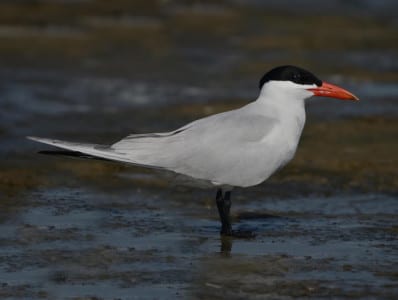
Terns are gull relatives that normally dive into the water for their food of fish (usually).
The Caspian Tern above is the largest in NA and has a thick, red bill and a short tail,
barely forked. They feed in shallows and often take largish fish like finger ling mullet.
There are a few hundred pairs breeding in Galveston Bay.
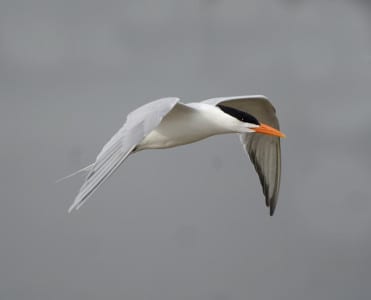
Royal Terns are more slender than Caspians with the thinner bill that’s more orange than
red and a long, forked tail. They fly out deep to feed and are often bring back fish we
don’t normally see. There are around 6000 pairs breeding in Galveston Bay.
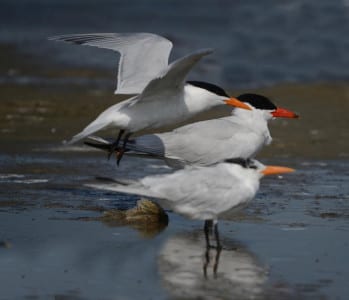
Note the difference between the breeding Caspian in back and the hover ing Royal, also in
breeding plumage. In front is a winter-plumaged Royal.
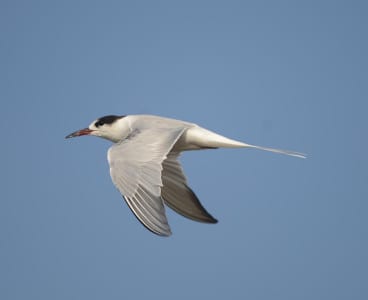
Common Terns are often around in flocks at this time, usually in the process of attaining
their red bill base and red legs. Their primaries are darker than the Forster’s, like the one
that’s in the middle of the Commons below. They have orange where Commons have red.
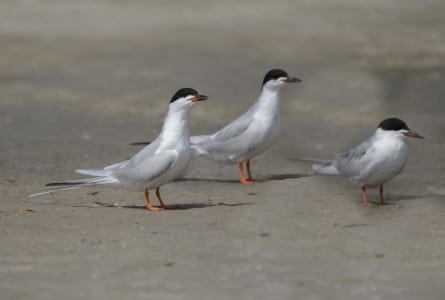
Here you see a Common Tern on the right with two Forster’s on the left. Note the color
of the bill and legs and the shady underside of the Common on the right. Notice these two
are much smaller than the Caspian and Royal.
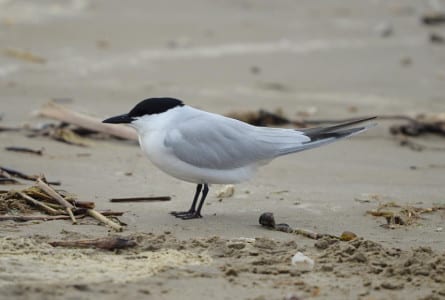
Gull-billed Terns are terrestrial feeders over salt marshes and dry marshes. The short,
thick, black bill is used for grabbing fiddler crabs, grasshoppers and dragonflies. The
back of this species is grayer than other terns. These and the next are medium-sized terns,
between the sizes of the last two pairs.
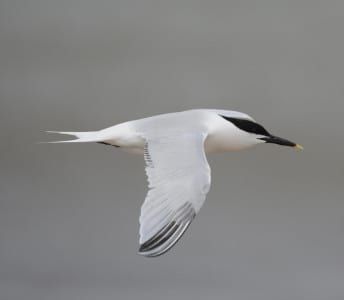
There are over twenty thousand pairs of Sandwich Terns nesting in Galveston Bay. They
have a yellow tip on their black bill, and they join Royals going deep for food. Both are
often seen in spring flying over the Island, on their way out and back for their youngsters.
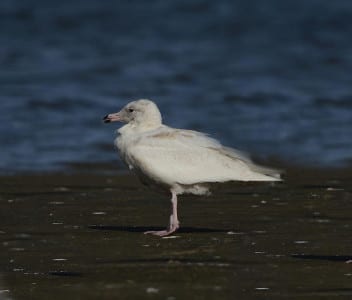
There are several species of white gulls that can be seen in North America, from the tiny
Ivory Gull to this mammoth Glaucous Gull. It has a pink bill with black tip, as the vast
majority of our records are immatures. Note the large, f lat head.
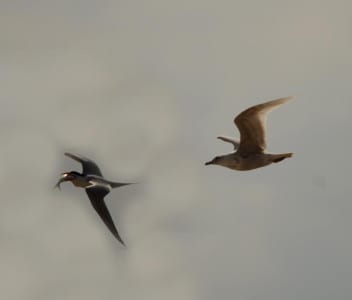
Glaucous and these Thayer’s Gulls are separated from light, immature Herring Gulls as
the latter has dark primaries. Note the Thayer’s above has light primaries, as he’s chasing
a Royal Tern with a mouth full of fish. This species is occasionally seen in April, likely
heading north to breed. It should be no surprise that white gulls breed in the Far North.
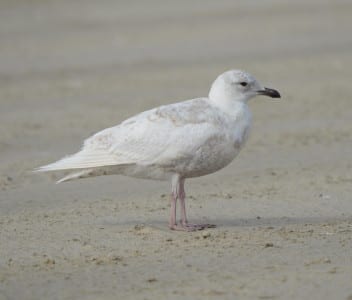
The same week the two large, white gulls above were seen (by me with clients) at San
Luis Pass, this bird showed up at SLP, representing one of the very few Iceland Gull
records for the Gulf Coast. Note the small, rounded head and small, black bill.
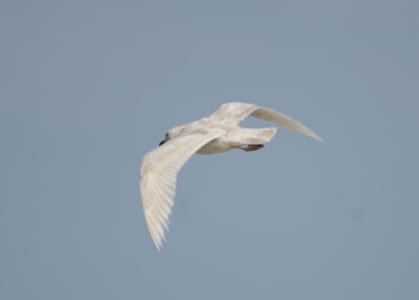
Note the light primaries on this Thayer’s Gull, kinda like Iceland, Glaucous and any other
white gull. Even summer-bleached Herr ing Gulls, which become almost white, have dark
primaries. That is a crucial fact for gull-watchers to know!
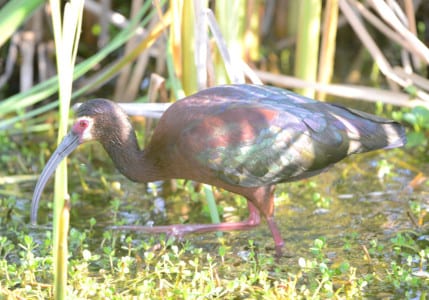
This dark ibis is a White-faced Ibis in breeding plumage. Note the red legs and white face
that goes BEHIND the eye. They are on the Western Gulf, but Glossies Worldwide in
equatorial regions (and the eastern Gulf and Atlantic States). See below…
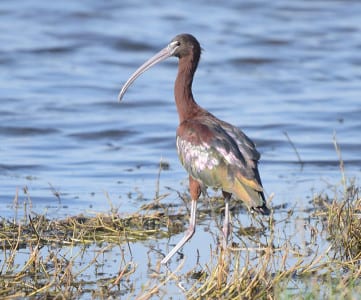
Along the Eastern Gulf, especially in Florida, is the Glossy Ibis. Note the bluish-white
face that does NOT extend behind the eye. They are both found easily in Louisiana, as
Glossies are scarce in Texas.
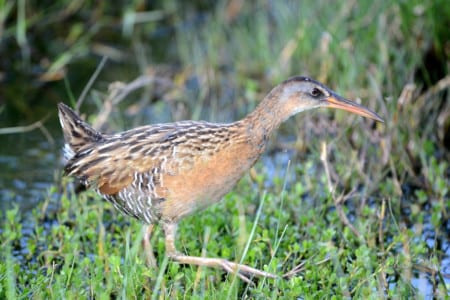
Also a Bayou State victim is the King Rail, a denizen of freshwater. They are slightly
larger and more richly-colored than Clappers, (rails, not toilets) and have a more
pumping sound while calling.
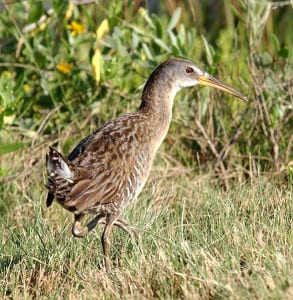
Here is the Clapper Rail, and note how grayed out he is. These only live in salt marshes,
often feeding on fiddler crabs.
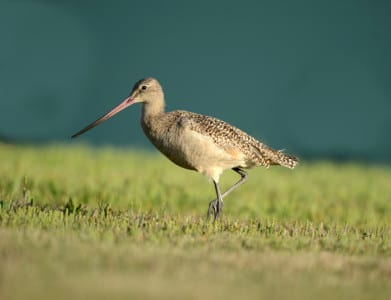
Godwits are very large sandpipers with two-toned, upturned bills. This Marbled Godwit
is a common winter resident along the Texas Coast, with the vast majority heading
northwest to breed in the Shortgrass Prairie.
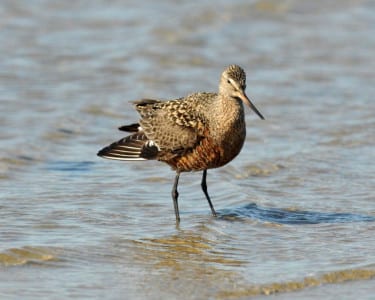
The rare Hudsonian Godwit pass through in late spring on its way to the Arctic to breed.
They are smaller than Marbled but richly colored. They are most easily seen in inland
rice fields with other grasspipers. This one wasn’t easy…
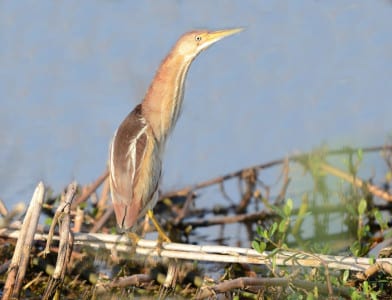
Least Bitterns are summer residents in Eastern North America, even into the Far West.
They are obviously small and lack the heavy streaking that their larger cousins have.
Bitterns are found in marshes such as cattails, eating most vertebrates they can catch and
swallow.
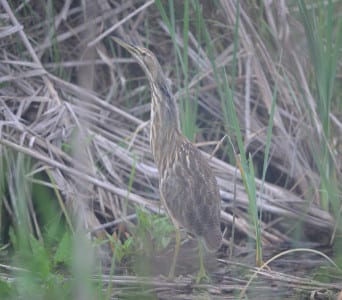
American Bitterns are winter residents in many of those same marshes where Leasts
breed. They are most similar to young night herons but are more streaked on the neck.
They will be gone soon until fall.
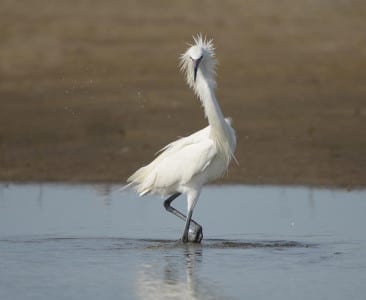
White morph Reddish Egrets have black or bluish legs (the latter in the breeding season)
and a black bill (which gets a flesh-colored base in the breeding season). Also notice the
shaggy feathers and very active feeding style.
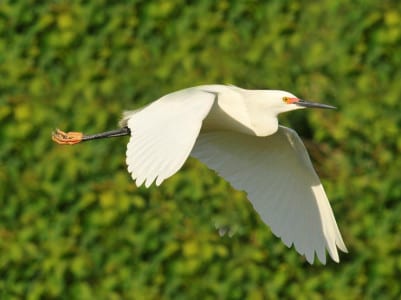
Snowy Egrets are smaller with yellow feet (reddish in high breeding plumage) and red or
yellow on the cere. They feed standing still UNLESS they’ve been in the company of a
Reddish Egret. Same is true for Tri-colored Herons.
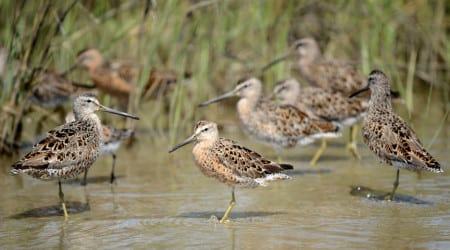
Above is a salt marsh flock of Short-billed Dowitchers in many different stages of
plumage change. Many birds do this in spring. Note the dark dots on the orange chest.
Below, and more often in freshwater, Long-billed Dowitchers have dark barr ing on a
more reddish chest. They make peeping calls while Short-billed Dowitchers say tu tu.
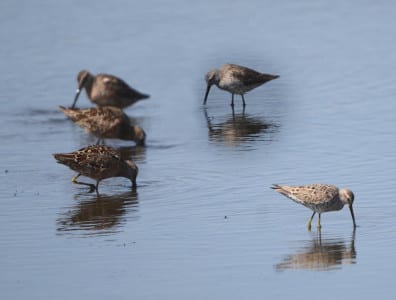
Here are Long-billed Dowitchers with a Stilt Sandpiper on the right. These uncommon
shorebirds are often overlooked among dowitchers. They will bend way over, though,
unlike the dowitchers, whose long bills negate the need for such stooping. This one isn’t
doing that. Naturally. :0
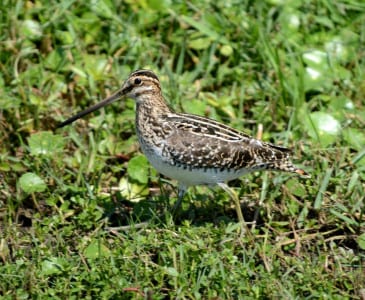
Also with a long bill is the Wilson’s Snipe, a winter resident seen in ditches and the edge
of marshes and wet grass. They shouldn’t be confused with dowitchers unless you have
those $25 Tasco binoculars. 😉
Note: The name “Common” means, “common to the Old and New World,” so when our
bird was separated from the European one, we had to find a new name (as did they). Of
course, Alexander Wilson was “up there” with Audubon and Peterson.
![Whimbrels are fiddler crab-eating curlews that migrate through here in spring, although they pass more down the Atlantic Coast in fall. [A few winter on the oyster bars in Galveston Bay, often from our sight.] Note the dark stripes over the crown, reminiscent of the Worm-eating Warbler. Curiously, they eat worms, and worm-eaters don’t, as they actually take caterpillars! Riveting, eh?](https://www.crystalbeachlocalnews.com/wp-content/uploads/2014/05/Tough-Pairs27-405x300.jpg)
Whimbrels are fiddler crab-eating curlews that migrate through here in spring, although
they pass more down the Atlantic Coast in fall. [A few winter on the oyster bars in
Galveston Bay, often from our sight.] Note the dark stripes over the crown, reminiscent
of the Worm-eating Warbler. Curiously, they eat worms, and worm-eaters don’t, as they
actually take caterpillars!
Riveting, eh?
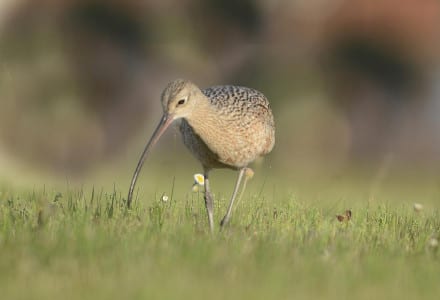
Long-billed Curlews will also eat fiddlers but often roam the grasslands for invertebrates.
Note the absence of crown stripes, plus a longer beak than Whimbrels. They are also
more of a tan color, like Marbled Godwits, and frankly aren’t always easy to tell from
godwits when flying at a fair distance.
Many thanks to Alan Murphy for teaching me to sometimes shoot birds from their level,
along with the many, many other pearls of wisdom. His work is a creative as it is
marvelous, but his generous imparting of photographic wisdom sets him further apart
from the camera masters I’ve known.

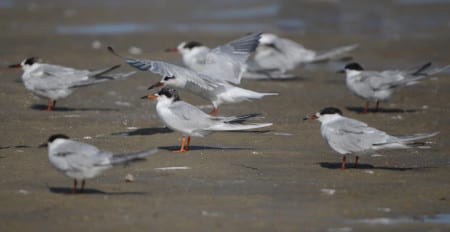
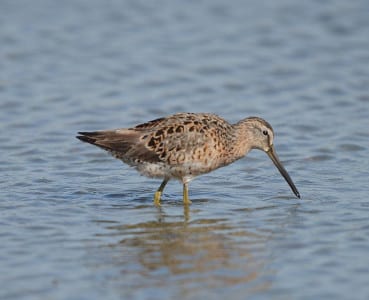
 Posted in
Posted in 
























